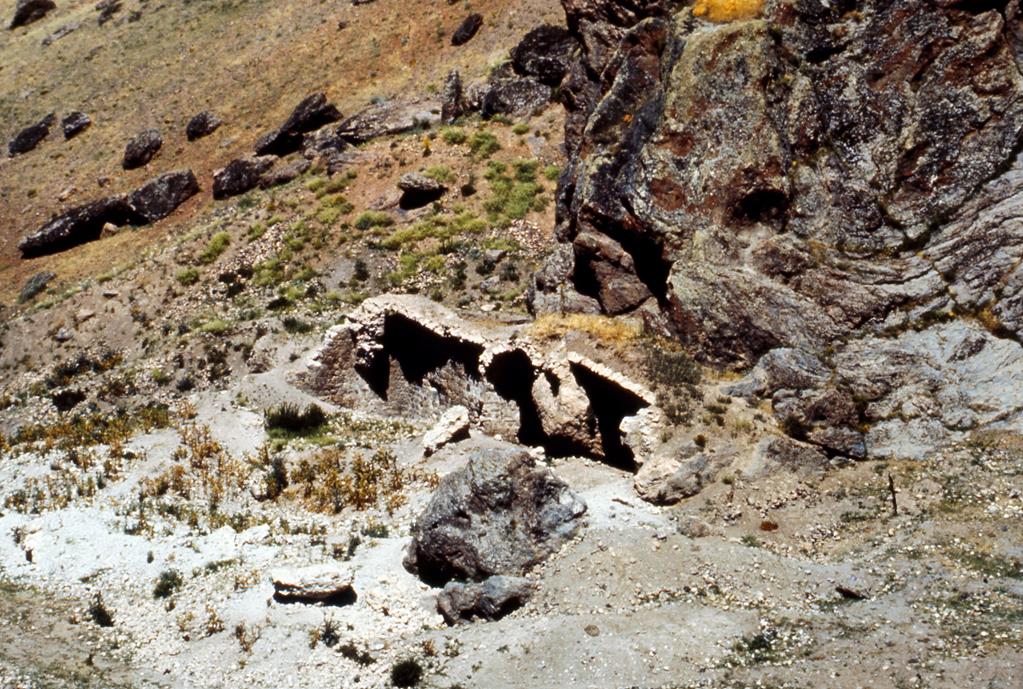Like Ardzwaper (n° 7), the Medzop‘ monastery, whose name – which is also that of a village – has been interpreted as Medz(n) Op‘, or “Big Pond”, lies at the foot of the Dzaghgants mountains [Meydan Boğazı], which run along the north shore of Lake Van, at 39° 10’ N and 43° 11’ E. Dedicated to the Holy Mother of God, the monastery was built in the shelter of two gorges, northwest of Arjesh [Erciş], between the village of Harut‘iun [***] and a pond higher up which is perhaps the Medz Op‘ [Meydan Gölü] in question; it lies on the left-hand side of the Aghi River [Zilan Çay] north of the village of the same name [Kocapınar].
The monastery was already active in the 12th century and, in 1201, the monk Asdwadzadur of Arjesh (Asdwadzadour Arjishetsi ) completed construction of a church there. Until the 16th century, Mezsop‘ would be repeatedly mentioned as a scriptorium and as a center of learning and a retreat. The 14th century witnessed the work of Mekhitar of Sassun (Mekhit‘ar Sasnetsi, † 1337), author of homilies and commentaries, and then John of K‘adshperunik‘ (Hovhannès K‘adchperantsi) who, after having studied in eastern Armenia with the famous doctors and theologians John of Orodn (Hovhannès Orodnetsi) and Gregory of Dat‘ev (Krikor Dat‘evatsi), breathed new life into the Medzop‘ monastery school at the end of the same century. This abbot entrusted the Greek architect Faradj, from Mardin, with reconstructing the church, which he did between 1402 and 1409. Thomas of Medzop‘ (T‘ovmas Medzop‘etsi, † 1447), a memorialist and major figure of the 15th-century Armenia, was his disciple; he studied at Medzop‘ but also at the neighboring Ardzwaper monastery (n° 7) and at the monastic university in Dat‘ev. While the copyists at Medzop‘ pursued their writing and illumination, in which he participated, Thomas consolidated the teaching of his master at Medzop‘, of which he became prior. Among his students was the Doctor, James of Crimea (Hagop Khrimetsi), who joined the Medzop‘ community after studying with George of Erznga (Kevork Erzngatsi) at the Great Abbey (n° 44). But above all, Thomas of Medzop‘ played a leading role in the return of the catholicos of Armenia to Vagharshabad (Edchmiadzin) in 1441, a consequential undertaking. This feat nevertheless remained a semi-success, since the incumbent catholicos and then his successors refused to vacate the seat of Sis [Kozan] in Cilicia; this prompted a new election (see n° 7). It was supposed, without any real proof, that Asdwadzadur I, the first Armenian primate of Constantinople to bear the title of patriarch (1537-1546), had belonged to the Medzop‘ community. At the turn of the 17th century, the decline of Medzop‘ in the wake of the Turko-Persian wars inspired one of the monks, Simeon of Abaran (see n° 30), to pen an elegy: “ […] Awake, Jeremiah / And waken your harp of lamentations […]”. The monastery nevertheless survived for several more centuries. It was laid waste in 1895 and again in 1915. The last prior of Medzop‘ was Father Sahag of Pakrevant, ***.

Vue générale, 1972 (Fonds N. et M. Thierry).
The Medzop‘ monastery consisted essentially of the church of the Holy Mother of God “Mother of Light”, a narthex and outbuildings. Built of joined stone and completed in 1409, the church had a drum and a dome, caches in the upper walls of the building and two chapels, perhaps chambers set on either side of the apse. The walls bore at least three old inscriptions dated 1409, 1432 and 1571, as well as cross-stones. This can be gathered from 19th- and early 20th-century descriptions. In the absence of contemporary photographs, no more can be said; the same is true of the narthex built in front of the church and of whatever buildings there may have been, about which we know nothing. South of the monastery lay the cemetery, where, among the other tombs, one could see those of Mekhit‘ar of Sassun and Thomas of Medzop‘. The monastery farm was in the nearby village of Harut‘iun “[Holy] Resurection”. Most of the village worked on the monastery’s property, composed of plow lands, grazing land and sheepfolds. Three other villages lay in the jurisdiction of Medzop‘.
Confiscated after the Great War, the Medzop‘ monastery was methodically destroyed. In the 1970s all that remained were piles of rubble and a cross-stone bearing the date 1614. Today hardly any trace of constructions can be discerned.
Oskian, 1940-1947, II [1942], 419-442. Djilizian, 1947, 5-12. Thierry, 1989, 205-206. Khatchikian, 1999, passim.